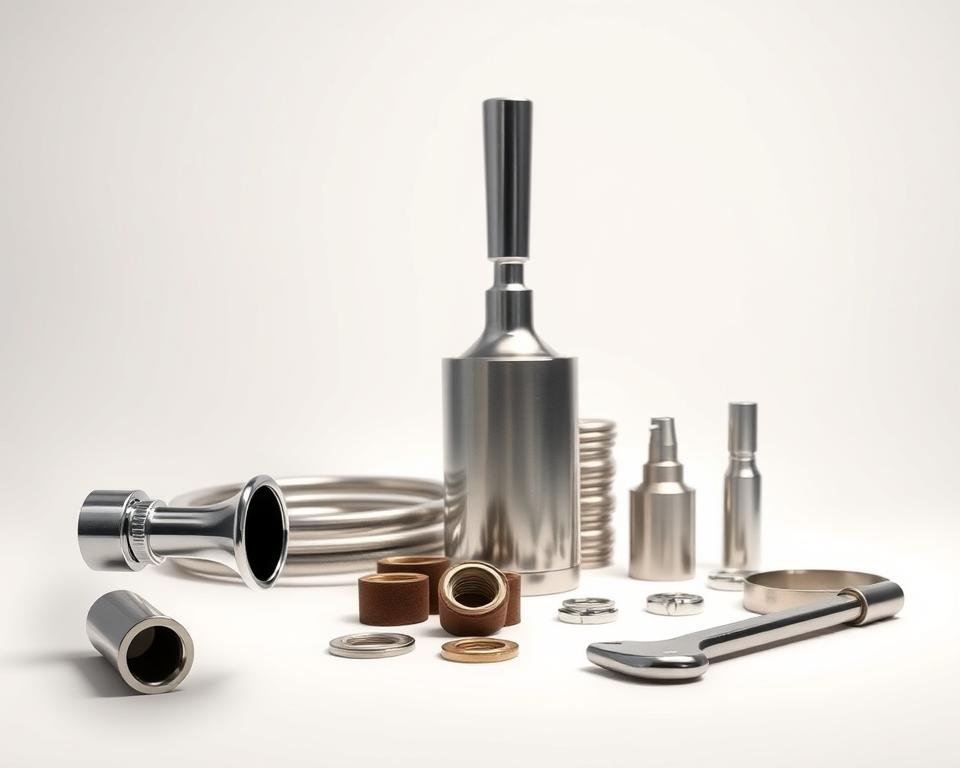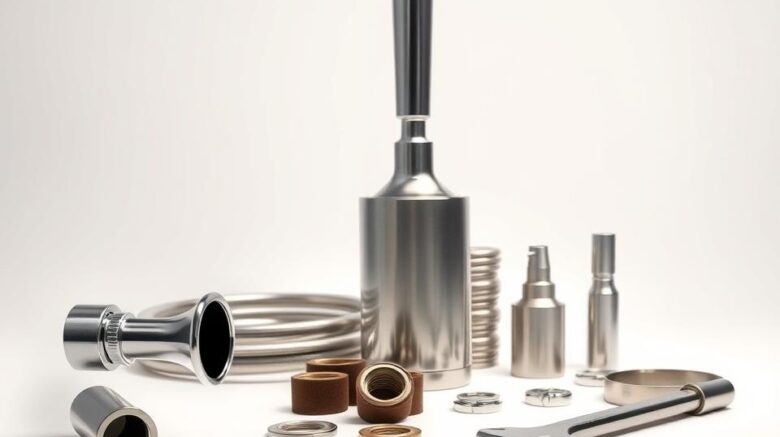Kegerator Coupler Parts: Essential Accessories for Your Home Keg
Have you ever questioned why your draft pours either full of foam or completely flat? Those issues often trace back to the little parts that bridge your keg and tap. If you don’t have the proper hardware, even a great beer can go flat and lose its taste.
At Installation Parts Supply, we know that a smooth pour starts with quality hardware. No matter if you brew at home or simply enjoy draft beer, knowing these beer tap parts parts makes all the difference.
Every part—from the washers to the gas lines—matters for keeping the right pressure and taste. More than nine out of ten pour problems stem from mismatched or worn parts. With a bit of know-how, you can keep your setup working without a hitch.
Central Ideas
- Choosing the right coupler guarantees ideal flow and taste.
- Count on Installation Parts Supply for trusted draft setup parts.
- Keeping parts clean and checked avoids typical pouring glitches.
- Various brews call for particular coupler designs.
- Most system failures originate from coupler-related issues.

Kegerator Coupler: An Overview
A flawless draft begins with the proper keg-to-tap link. Think of the keg coupler as the connector between your CO₂ cylinder or nitrogen tank and the beer line, employing pressurized gas to deliver beer flawlessly to your taps. Consider it the powerhouse of your draft beer system—remove it, and the flow stops.
It both pumps gas in to pressurize your keg and regulates how the beer exits. Inside, you’ll find a probe, a check valve, and separate ports for gas and liquid. These components work together to maintain carbonation and prevent excess foam.
| Component | Function | Common Issues |
|---|---|---|
| Coupler Probe | Pierces the keg’s cap | Leaks if not aligned properly |
| Return Valve | Stops beer from flowing backward | Flat pours from worn seals |
| Gas/Liquid Ports | Connects to lines | Foaming from loose connections |
Seventy-five percent of newcomers misattach the coupler, causing issues. End results include overflow foam, drips, or wasted brew. Installation Parts Supply offers compatibility charts and video guides to help you get it right.
Even “universal” styles need to correspond with your keg’s standards. Using the wrong coupler can harm both your pour and your gear.
Which Keg Coupler Is Right for You?
Kegs come in many styles and each needs its matching coupler. Using the proper coupler keeps your beer fizzy and flavorful. Here’s how to pick the perfect fit.
D System (Sankey) Coupler
Most North American brews—about 85%—use this style. The one-valve mechanism snaps firmly into place. Tip: Check for “Sankey” etched into the coupler.
U-Type Coupler
Recognizable by its harp logo, this type is a must for nitro beers like Guinness. A 75% nitrogen mix gives you that signature creamy foam. A U coupler will not seat on a D-type keg—don’t attempt it.
S System (European Sankey) Coupler
Heineken and other European imports need this reverse-thread version. That reverse threading avoids confusion with standard Sankey. Fun fact: It’s slightly taller than its American cousin.
A, G, and M System Couplers
Certain European brews need these specific coupler types:
- A System: Slides onto Warsteiner or Paulaner kegs. Its sliding latch design is fail-safe.
- G-Type Coupler: Fits Bass and Boddingtons with its tri-flat stem. A pub staple across the UK.
- M System: Locks onto Schneider Weisse kegs. You’ll hear a click once it’s set.
Their guide highlights D in green, U in black, S in blue. A Midwest microbrewery saved $3,000 yearly by switching to correct couplers. Remember: True compatibility beats “universal” claims every time.
Essential Kegerator Coupler Parts and Their Functions
That perfect pour depends on finely tuned parts. These small but mighty pieces ensure your beer stays carbonated and flows flawlessly. Let’s break down the key hardware that keeps your system running.
Coupler Probe & Check Valve
A stainless probe punctures the seal to regulate flow. Premium models last 3x longer than economy versions. Underneath, the check valve stops reverse flow—our top replacement item.
Hex Nut and Washers
Your seal depends on that hex nut. Brass is economical; stainless fights rust. Nitrile outperforms EPDM under 40°F.
| Component | Material | Key Benefit |
|---|---|---|
| Coupler Probe | SS | Resists wear |
| Return Valve | Food-grade plastic | Stops foam issues |
| Coupler Nut | Brass/Stainless | Cost-effective & durable |
Gas & Beer Ports
Your gas port should see 20–30 PSI pressure. Wrong PSI leads to foam. Stick to 3/16″ ID beer lines for smooth pours. Rebuild kits with FDA seals simplify maintenance.
Pro Tip: Change seals twice a year or per 50 kegs. A few dollars in washers beats hundreds in repairs.
Coupler Installation Guide
Install correctly for flawless drafts. Correct hookups avoid pouring issues. Follow these steps to connect everything smoothly.
Connecting the Coupler to the Keg
Open the handle, fit lugs into place. Turn clockwise until snug—over-tightening damages the seal. Choose low-profile to gain 4–5″ clearance.
Our wrench sets hex nuts to the ideal 8-10 ft-lb. A misaligned probe causes 80% of leaks. Always use fresh washers to maintain pressure.
Hooking Up Your Gas & Beer Lines
Connect the gas hose to the coupler’s port using 5/16″ MFL fittings. A bit of sealant stops gas leaks. Keep beer tubing 10-12′ of 3/16″ ID for best flow.
| Task | Equipment | Tip |
|---|---|---|
| CO₂ Line | Pipe dope | Check with 30 PSI leak test |
| Draft Line | Pipe cutter | Cut straight for proper seals |
| Pressure Test | Soapy water | Check for 24 hours |
Modern rigs offer app-based pressure feedback. Our quick-connects helped a Denver bar slash foam by forty percent. Turn off gas immediately if you spot big leaks.
Troubleshooting Common Coupler Issues
Nothing ruins a cold beer faster than foam spraying everywhere. Once you know what to check, most issues are easy to fix. Here are the usual culprits and how to remedy them.
Foamy Beer Solutions
Sixty-eight percent of draft issues are foam-related. Ensure your temp hovers around 38°F to control foam. Warm beer releases CO₂ prematurely.
Next, inspect your beer line connections. A soapy water solution reveals gas leaks through bubbles. Use a wrench to snug loose parts, avoiding over-torque.
- Check ball may hiss and interrupt flow
- Pressure imbalance? Compare your gauge to this chart:
| Beer Type | CO₂ PSI | N₂ Ratio |
|---|---|---|
| Pilsners | 10–12 | N/A |
| Nitro Stouts | 25–30 | 75% nitrogen |
Coupler Fit Problems
If your coupler fits loosely, first check for worn O-rings. Replacing seals corrects about 40% of these problems. Warped coupler faces may need replacement.
Use plastic shims to level off rough keg tops. These inexpensive plastic wedges stabilize wobbling connections. Choose low-profile for compact spaces.
Pro Tip: Their emergency washer kit contains five critical seals. A Chicago bar cut waste by 18% after training staff on these quick fixes.
Remember—frost on your CO₂ tank signals overuse. Defrost before tweaking the relief valve. Annual gauge calibration keeps readings true.
Coupler Cleaning & Care
Clean lines equal better-tasting beer. Leftover yeast and oils harm both taste and pouring. A quick cleaning regimen prevents issues.
Disassembly and Soaking
Begin with a full teardown. Remove the handle, probe, and check valve. Let the parts sit in warm PBW solution (1 oz/gallon) for 15–20 minutes. This removes yeast and hop oils.
Installation Parts Supply’s brush set reaches tight spots. Pay extra attention to the ball valve—it’s a common hiding place for gunk. Rinse thoroughly to avoid soapy aftertastes.
Best Coupler Cleaners
PBW (Powdered Brewery Wash) is a top pick for its pH balance. Acid cleaners work faster but can damage rubber over time. Sound-wave cleaners strip away stubborn grime.
- Air Drying: Remove moisture with air or cloth.
- Disinfecting: Meet FDA CFR 117: 30 seconds to sanitize.
- Record-Keeping: Track cleanings with a template.
UV light options add extra protection for rubber components. Rinse waste per regulations—PBW can damage plumbing. A quick clean routine preserves flavor and longevity.
Wrapping It Up
Enjoy crisp, fresh beer by mastering your draft beer system. Choose compatible parts, maintain them well, and install correctly. Count on Installation Parts Supply for ongoing support and rebuild-kit deals.
Regular upkeep can stretch your hardware lifespan by seven years. Download their free compatibility checklist or join a brewmaster webinar for pro tips. An annual check-up guarantees smooth service—just listen to customers with five years of trouble-free use.
Time to level up: head to Installation Parts Supply and improve your home bar.
